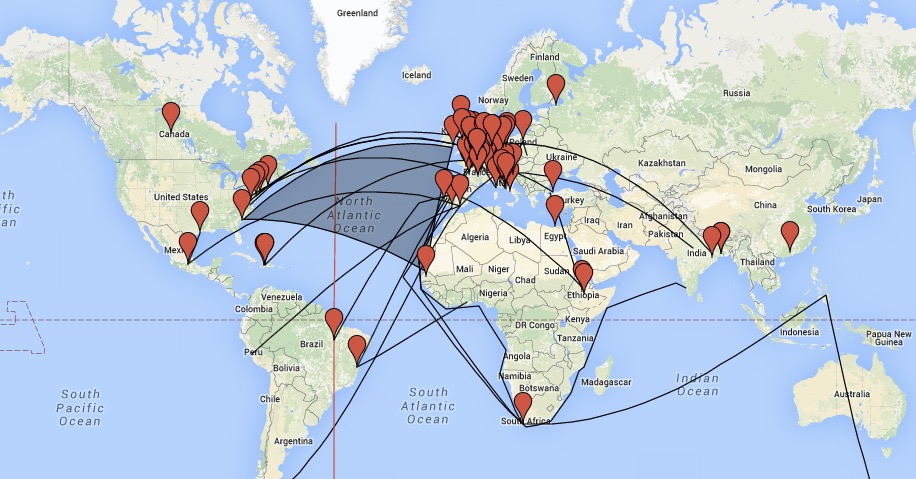
Public History Projects: An important part of being a twenty-first-century historian is engaging the public with our work. As a way to connect the larger public to my research and teaching, I regularly publish small public history pieces (some peer-reviewed and some blogs). As of April 2018, I am a regular contributor to The Junto. In addition to the public history pieces below, I also am available to speak to the public on any topic concerning the history of the early modern and revolutionary eras in Europe and the Atlantic.
Articles and Blogs:
- “Part of the Long History of Child Trafficking: 18th-Century French Louisiana,” The Junto, posted June 27, 2018.
- “Twitter Conferences: To Do or Not To Do?,” The Junto, posted May 24, 2018.
- “Why We Doubt Capable Children: Constructing Childhood in the Revolutionary Era,” The Junto, April 17, 2018.
- “Teaching the Early Modern Penis-Vagina,” Notches, posted March 2018. Peer-Reviewed.
- “Food in the West: Using TimelineJS in the Classroom,” AHA Today’s Teaching with #DigHist, posted March 2018.
- Podcast, Episode 103, “French Child Ambassadors in the East,” 15 Minute History, Feb 2018
- “Mapping the Early Modern World: Using Google Maps in the Classroom,” AHA Today’s Teaching with #DigHist, posted October 2017.
- Podcast, Episode 96: Louis XIV’s Absolutism and the “Affair of the Poisons,” 15 Minute History, September 13, 2017
- “Child Gangs and Motherly Duty at the Onset of Revolution,” Age of Revolutions Blog, August 2017
- “Prix de Moralité: The Inculcation of Young French Citizens,” at Age of Revolutions Blog, June 2017
- “Review: A Tale of Two Murders: Passion and Power in Seventeenth-Century France,” Not Even Past, October 2010, http://www.notevenpast.org/read/tale-two-murders-passion-and-power-seventeenth-century-france-2005
- “Death and Decadence: Vatel,” Not Even Past, May 9, 2011, http://www.notevenpast.org/watch/death-and-decadence-vatel
- “Review: Sarah’s Key,” Not Even Past, September 7, 2011, http://www.notevenpast.org/read/sarahs-key
- “Why is Anne Hathaway So Sad? The History Behind Les Misérables,” Not Even Past, January 14, 2013, https://notevenpast.org/why-anne-hathaway-so-sad-history-behind-les-miserables/
- “Les Misérables: A Historian’s Review,” The Alcalde, January 16, 2013, http://alcalde.texasexes.org/2013/01/les-miserables-a-historians-review/
- “Review: State of Virginity: Gender, Religion, and Politics in an Early Modern Catholic State,” Not Even Past, February 17, 2013, http://www.notevenpast.org/read/state-virginity-gender-religion-and-politics-early-modern-catholic-state-2004
Invited Presentations and Media:
- Radio Guest, “Beyond Your Command,” BBC 4 Radio Show “When Greeks Flew Kites,” Aired March 2018
- Invited Presenter, “Reporting and Propaganda in the American Revolution,” The 300th Military Intelligence Brigade’s 29th Annual Language Conference, Utah National Guard, March 4, 2018
- Invited Lecturer, “New Methodologies: Digital History,” HIST 3000: Methods (Dr. Conte), Utah State University, February 2018
- Invited Lecturer, “Experiences with French Archives,” Archives Management Class, Utah State University, September 2017
- Invited Guest and Presenter, “Tattletales: Children and Authority in 18th-Century France,” Faculty Forum, October 2016, Utah State University
- Invited Panelist, “How Historians ‘Do’ Gender History,” The Department of History’s Graduate Symposium on Gender, History, and Sexuality
Digital History Projects: Digital sources are excellent examples of how our current world is experiencing a digital revolution similar to the early modern world’s print revolution. Information can now be accessed and created more easily and faster than ever before. With the myriad advantages that come from open-access, there are also a number of disadvantages, namely digital illiteracy. Although digital tools can be helpful to students when applied correctly, students often do not know how to wield them. Despite the fact that most of our students are digital natives – people who grew up with knowledge of and access to personal computers, information technology, and nearly constant technological innovation – there is an alarming amount of digital illiteracy among students. Therefore, in addition to using digital sources in my classes, I organize activities and assignments that foster digital literacy. Students learn how to identify digital sources, use them, and even participate in the making of digital sources.
In this section you will find examples of digital history projects my students have done (or are currently doing). All use open-access platforms that teach students historical skills like evidence selection, bias identification, writing, and analytical skills. Similarly, it teaches students important organizational skills and, depending on the project, about working together in teams and peer evaluation. At the same time, students learn how to use platforms like Google Docs and Omeka that will help them in a variety of career settings.
Each project has a brief description and detailed instructions.